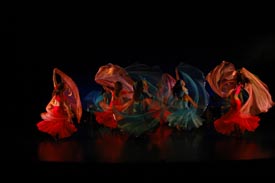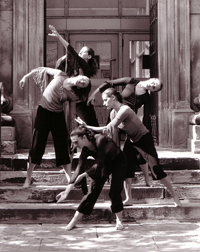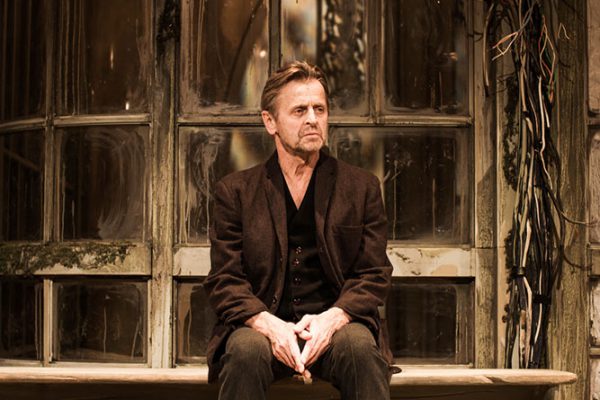The 12th annual edition of the Moving Pictures Festival of Dance on Film and Video, curated by Kathleen M. Smith and Marc Glassman, opened in grand style, with a ballet-based evening of screen dance. (In full disclosure, it’s best to come forward right from the start and say that I, along with Lynette Kessler, filmmaker and co-founder/co-director of Dance Camera West in Los Angeles, were invited to be on this year’s jury, and what follows is a perspective of the festival, a kind of public reading of what transpired, from that point of view.) The program began with the world premiere of Veronica Tennant’s “A Pairing of Swans”, featuring the indomitable but rail thin Evelyn Hart as the Dying Swan, unforgivably shot at times to look as if she is wearing a death mask. Rex Harrington dances “The Swan Sees His Reflection” in the second part of Tennant’s film, in a new and exciting work by Matjash Mrozewski, the red-hot choreographer whose career is expanding by leaps and bounds. Weaving the sections together is a leaden-sounding and looking Brent Carver, who recites some babble about Pavlova and the dance. This is the kind of heavy-handed picture that should have been an homage but isn’t. The premiere of Barbara Willis Sweete’s “The Firebird”, Rhombus Media’s big-bucks high-definition production of James Kudelka’s choreography for the National Ballet of Canada, was the major event on this opening-night program. Based on the superficial Russian tale of noble love and conquest, the film is a trimmed down version of Kudelka’s stage production. Set in a faux forest of scrawny trees, the Firebird (Greta Hodgkinson) flits and hovers over the lovers (Rebekah Rimsay and Aleksandar Antonijevic), and the duelling overlord (Rex Harrington). In an inadvertant nod to Norma Desmond/Gloria Swanson in “Sunset Boulevard”, the acting is way over the top — big eyes, startled expressions and flaring nostrils are the order of the day — as is some of the camera work, which angles in on some equally ripe crotch shots.
The Bravo!FACT program, produced by spirited Bravo!FACT Executive Director Judy Gladstone, was a much more steady affair, unveiling a full slate of new short works from the cable arts broadcaster. “Light Years”, director Jenn Goodwin’s biographical piece on Montréal dancer-choreographer and pedagogue Elizabeth Langley, celebrates the septuagenarian’s energy, spirit and expressive sense of creativity. “Departure”, a visually beautiful work co-directed by Mark Adam and Allen Kaeja, is yet another evocative venture by choreographer Kaeja into the world of Holocaust Europe. Adam also filmed a stunning steamy ballet/hip hop duet, an adaptation of Victor Quijada’s “Hasta La Proxima”, which details a moment in time linked to 9/11. The Alberta-based duo of Sandi Somers and Nicole Mion also had two entries on the evening’s roster: a revisiting of “The Riders”, this year featuring two male dancers in a homoerotic duet (last year, the version featured two women), as well as “Porcelain Tattoo”, a moody exploration of performer Stephen Thompson’s Eurasian background. Toronto Dance Theatre Artistic Director Christopher House made his directorial film debut with the inadvertently comic “Falling Gothic Green”, inspired by an Arthurian poem. Mythology is brought to life in some beautiful terrain, with cavorting dancers/nymphs in a forest setting.
At the Bravo!FACT cocktail party following the program, über-host Gladstone made sure the networking crowd met new people and forged connections. In the Canada Dances series, director Alison Murray made an impact with the engaging “Aeroplane Man” using an easy-going camera style to capture British-based writer-performer Jonzi D. riffing on the idea of homeland. In her directorial debut, Marie Chouinard’s “Cantique #1” presented powerhouse performances by Carol Prieur and Benoît Lachambre. A tongue dance is captured in close-up profile, every breath and vibration amplified. At fifteen minutes, and too long by several minutes, the playful, primal images resonate. “Through using facial gestures and sound, the magnificent performers display courage, sustained intensity and uncommon daring,” said the jury. “They embody a primordial understanding of the choreographer and her intentions.” Frédéric Moffett’s “24X Caprices”, based on choreography by Montréal’s Manon Oligny, won the festival Cinedance Award. The filmmaker has an eye for composition along with an awareness of detail, texture and atmosphere that gives her the ability to render the body in intimate ways. The film invokes the world of women and renders them beautifully in the medium through the judicious use of close-ups, sound and editing.
Programmed in the Global Moves section of the festival, “Burst” is choreographed by artistic director of the Iceland Dance Company Katrin Hall and won The Paula Citron Award for Choreography for the Camera. A couple fights in the restrictive space of their bedroom, which slowly becomes submerged in water from a burst pipe. Directed by Reynir Lyngal, known for his work in TV commercials and music videos, the film references cartoon-like sequences and martial arts. The choreography is tense and taut. The movements jolt the viewer into the dynamics of the couple and their relationship. The jury also gave a special citation to the US-South African “Guguletu Ballet”, also on the program. Set in the Townships, the “passionate documentary” shows “the power of dance for inspiring people to reclaim their humanity” and the power of the spirit in troubled times. In association with the Loop Collective, the festival also featured “Liquid Bodies”, an avant-garde program that explored representations of the moving body in relation to the moving image including experimental film, photography and installation work.
On the program highlighting jazz dance, audiences saw historic footage of black American dancers and musicians, including eighty-year old archival footage of the Nicholas Brothers, two great spirits of jazz dance. Spanning the Hollywood era, these films bear witness to a time of incredible racism and creativity in the motion picture industry. In one of the festival’s most ingenious events, known as The Pitch, several aspiring filmmakers pitched their story ideas to a panel of industry experts in competition for a film goods and services package valued at over $5,000. Filmmaker and photographer Stefan Chiarantano made an entertaining pitch for his upcoming film “Engendering the Valley of Flamenco” to a panel composed of Roberto Arigenello (LIFT), Lillyann Goldstein (Wallace Studios) and filmmakers Sandi Somers and Nicole Mion.
As the Moving Pictures Festival clearly established, the dance and film art forms are being re-examined and re-invigorated. Among the issues surrounding hybrid creations involving performance, media arts and new technologies, high-definition (HD) digital production was on people’s minds. (In terms of resolution, with over two million pixels, an HD camera has nearly six times the resolution of DigiBetaCam and standard DV formats.) With the notable exception of “The Firebird”, few dance for the screen productions in the festival were shot using HD, but that may be about to change. Fifteen years ago, when the HD medium was introduced, the material could only be seen on special HD screens. In the mid- to late-1990s, that began to change with impressive results. Now, and as confirmed by industry types, the HD image is at least equal to thirty-five millimetre film on many counts. With HD, you can treat the image in more painterly ways using texture, colour and special effects tools; and because it is a digital format, it will not suffer generation loss, i.e., the filmmaker will not lose image quality in the post-production process. This “you can do anything to it” perspective is changing the face of film and video production. The debate between the use of film or HD centres on image quality. Film is a transported image; it goes through the gate of a projector. Often there are dust particles or specks on the film that interfere with the image. However, this in part makes film look like film, which creates a distance between the viewer and the object. What we see in HD is brighter, sharper and ostensibly much closer to what we see through our eyes, that is, before the image is treated. To project HD, the image does not move within a mechanical device, so there are no particles or scratches to interfere with the viewing. Film feels different to what we see in real life. “We’ve been educated to view film, and we’ve become spectators to the artifice,” says filmmaker Philippe Baylaucq, a previous Cinedance Award winner for Lodela. “We don’t want reality, and film reaches us emotionally, and we’ve come to accept the filmic reality.” HD projection is substantially different. The pristine quality is what is captivating many filmmakers.
There are disadvantages. Apart from directors, art directors and others who work on film are becoming anxious and are facing challenges about how things “come out” on HD, because things simply appear as they are. Film makes things fuzzy, in the most positive sense; in filming you can patina what you work with. Though with HD you can treat the image with effects in post-production, what you see is, pragmatically speaking, what you get. The impression is that HD technology is changing cinematic boundaries, and even though it doesn’t fit every pocket book, it’s guaranteed that future festivals will be screening more work in this format, side-stepping prior standard technology. As it is, the festival is a nimble operation, presenting movies from the dance-film genre — some intense, some languid, many dreamy and sexy, and others sentimental and pretentious — in other words, it’s an expansive event, offering pictures for everyone.
Tagged: Dancefilm, Festival, Performance, ON , Toronto





